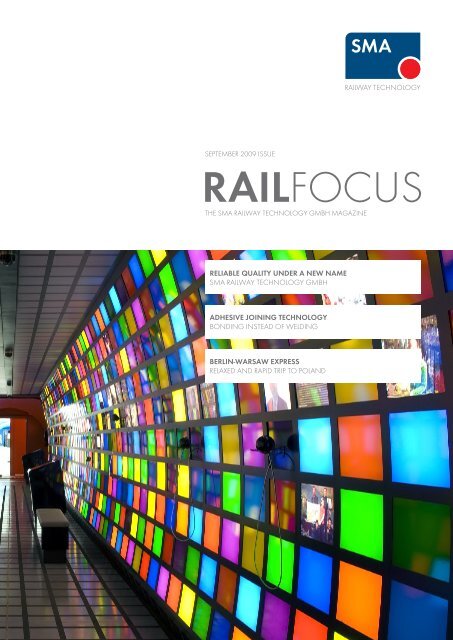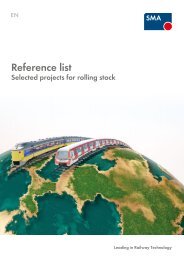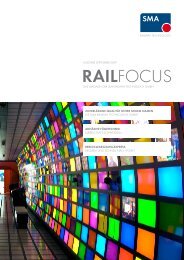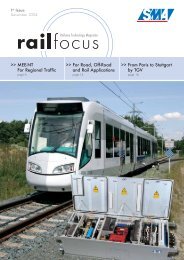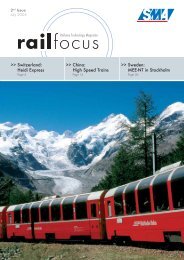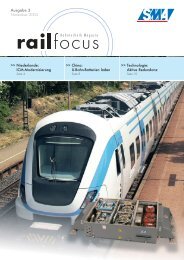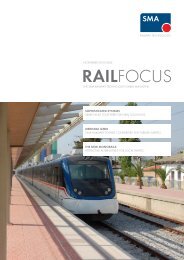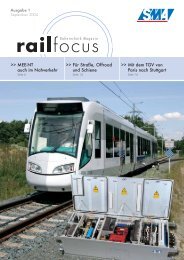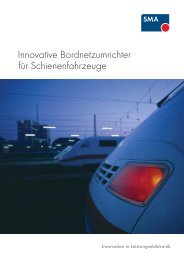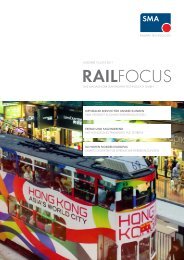RAILFOCUS - SMA Railway Technology GmbH
RAILFOCUS - SMA Railway Technology GmbH
RAILFOCUS - SMA Railway Technology GmbH
You also want an ePaper? Increase the reach of your titles
YUMPU automatically turns print PDFs into web optimized ePapers that Google loves.
SEPTEMBER 2009 ISSUE<br />
<strong>RAILFOCUS</strong><br />
THE <strong>SMA</strong> RAILWAY TECHNOLOGY GMBH MAGAZINE<br />
RELIABLE QUALITY UNDER A NEW NAME<br />
<strong>SMA</strong> RAILWAY TECHNOLOGY GMBH<br />
ADHESIVE JOINING TECHNOLOGY<br />
BONDING INSTEAD OF WELDING<br />
BERLIN-WARSAW EXPRESS<br />
RELAXED AND RAPID TRIP TO POLAND
02 Imprint<br />
Railfocus<br />
<strong>Railway</strong> <strong>Technology</strong> Magazine<br />
Published by:<br />
<strong>SMA</strong> <strong>Railway</strong> <strong>Technology</strong> <strong>GmbH</strong><br />
Miramstrasse 87<br />
34123 Kassel<br />
Germany<br />
Phone +49 561 50634-6000<br />
Fax +49 561 50634-6001<br />
Responsible for contents<br />
Dirk.Wimmer@<strong>SMA</strong>-<strong>Railway</strong>.com<br />
Coordination<br />
Daniela.Wagner@<strong>SMA</strong>-<strong>Railway</strong>.com<br />
Contact<br />
Info@<strong>SMA</strong>-<strong>Railway</strong>.com<br />
Railfocus <strong>Railway</strong> <strong>Technology</strong> Magazine is published twice a year<br />
German edition: 2,000<br />
International edition: 2,000<br />
Cover picture: Exhibition Train „Expedition Future“. © ArchiMeDes<br />
All trademarks are acknowledged, even if not explicitly identified as such. If not identified<br />
as such, this does not mean that a product or brand is not a registered trademark.<br />
This text and excerpts thereof may only be reproduced with the written consent of the<br />
publisher. Printed on 100% chlorine-free paper.<br />
All rights reserved.<br />
© 2009 <strong>SMA</strong> <strong>Railway</strong> <strong>Technology</strong> <strong>GmbH</strong>
Visit our new website at:<br />
www.<strong>SMA</strong>-<strong>Railway</strong>.com<br />
05<br />
06<br />
08<br />
10<br />
12<br />
14<br />
16<br />
18<br />
20<br />
22<br />
23<br />
Editorial<br />
News<br />
Reliable quality under a new name<br />
Berlin-Warsaw Express<br />
Adhesive joining technology<br />
High speed in Spain<br />
And the light goes on<br />
Destination Scania<br />
Expedition Future<br />
Service & Trade Fairs<br />
Outlook<br />
Content 03
DEAR READER,<br />
The railway technology division at <strong>SMA</strong> has seen many changes in recent years. The railway technology division,<br />
which has been in existence for more than 20 years at <strong>SMA</strong>, now has a new profi le: at the end of 2008 we<br />
moved into a new building, which gives us room to grow over the next couple of years and to manage this growth.<br />
Everything is under one roof: from development to manufacture to the test bay to customer service.<br />
The change of premises was accompanied by a new name for the division: since June 2008 the railway technology<br />
division has been consolidated into its own company, which we have called <strong>SMA</strong> <strong>Railway</strong> <strong>Technology</strong><br />
<strong>GmbH</strong>. By taking this step, we have adapted the organizational structure of the company in terms of size and<br />
strategic focus. With some 200 employees based at the Kassel site, the company is now large enough to invest in<br />
new technologies. But at the same time, it remains small enough to be able to react quickly and fl exibly to market<br />
developments.<br />
This important step has been rewarded with dynamic development in incoming orders. The fi rst months as <strong>SMA</strong><br />
<strong>Railway</strong> <strong>Technology</strong> <strong>GmbH</strong> were more successful than anyone could have hoped for. Despite record sales of<br />
more than €26 million in 2008, orders in hand have now increased to over €50 million. Several major orders<br />
have ensured a high level of capacity utilization over the next 5 years. With new development projects, the points<br />
are set for a successful technological future. <strong>SMA</strong> <strong>Railway</strong> <strong>Technology</strong> <strong>GmbH</strong> is thus in an excellent position to<br />
continue along the road to success.<br />
Hoping you enjoy this latest edition of Railfocus,<br />
Birgit Wilde<br />
Managing Director <strong>SMA</strong> <strong>Railway</strong> <strong>Technology</strong> <strong>GmbH</strong><br />
Editorial 05
06 News<br />
NEWS<br />
<strong>SMA</strong> supplies onboard converters for Mumbai Monorail<br />
<strong>SMA</strong> <strong>Railway</strong> <strong>Technology</strong> <strong>GmbH</strong> supplies<br />
onboard converters for the new<br />
monorail vehicles in Mumbai. These<br />
vehicles are equipped with our systems<br />
by Scomi Rail Berhad in Kuala Lumpur.<br />
The 60 onboard converters to be<br />
supplied belong to <strong>SMA</strong>‘s MEE-NTSD<br />
range, which is already deployed in<br />
similar form in the RegioCitadis vehicles<br />
in Kassel and The Hague. Deliveries<br />
from <strong>SMA</strong> started in the early summer<br />
of 2009 and will be completed in<br />
approximately one year.<br />
<strong>SMA</strong> <strong>Railway</strong> wins SBB bid<br />
Swiss Federal <strong>Railway</strong>s, SBB, has commissioned<br />
<strong>SMA</strong> <strong>Railway</strong> <strong>Technology</strong><br />
<strong>GmbH</strong> with the supply of onboard converters<br />
for the modernization of their<br />
EuroCity passenger railcars. This is the<br />
largest order in the history of <strong>SMA</strong> <strong>Railway</strong>.<br />
From 2009 to 2014, a total of<br />
240 passenger cars will be equipped<br />
with MEE-NTLD multi-voltage onboard<br />
converters from <strong>SMA</strong>.<br />
As part of the SBB‘s extensive modernization<br />
program, the EuroCity coaches will<br />
be converted so they can be deployed<br />
in national and international long-distance<br />
rail traffi c for another 25 years. This<br />
involves equipping the vehicles with new<br />
multi-voltage onboard converters from<br />
<strong>SMA</strong>, which generate the appropriate<br />
voltage for the consumers in railway vehicles<br />
from the various contact line voltages.<br />
For example, these devices are<br />
used to operate air-conditioning systems<br />
or to provide electric sockets in regional<br />
and long-distance trains. <strong>SMA</strong> <strong>Railway</strong><br />
<strong>Technology</strong> <strong>GmbH</strong> has specialized<br />
from an early stage on in the development<br />
and manufacture of multi-voltage<br />
onboard converters which, with their<br />
compact and modular design,<br />
could be adapted to the variety<br />
of demands found in international<br />
rail traffi c. All development and<br />
production stages take place at<br />
the Kassel factory. The fi rst <strong>SMA</strong><br />
onboard converters were delivered<br />
to the SBB works in Olten at the<br />
beginning of 2009.
MEE-NTSD for Izban and São Paulo<br />
MEE-NTSD onboard converters for ICM 3/4<br />
Following delivery of MEE-NTSD<br />
onboard converters for the ICM 1/2,<br />
<strong>SMA</strong> <strong>Railway</strong> <strong>Technology</strong> <strong>GmbH</strong><br />
will also deliver the systems for the<br />
ICM 3/4. The ICM 3/4 is a four-unit<br />
train, which is used by Netherlands<br />
<strong>Railway</strong> as an intercity train. As part<br />
of a comprehensive modernization,<br />
every ICM 3/4 will be fi tted with a<br />
new redundant energy supply system,<br />
realized with two independent MEE-<br />
NTSD onboard converters. Deliveries<br />
started in June 2009 and will be<br />
completed by the end of 2011. The<br />
modernization of the trains is being<br />
carried out by NedTrain in Haarlem<br />
(the Netherlands).<br />
The Spanish railway vehicles manufacturer<br />
CAF has commissioned <strong>SMA</strong><br />
with the delivery of a total of 134 onboard<br />
converters for the new regional<br />
trains of the Izban transport company<br />
(Izmir, Turkey) and the new vehicles of<br />
Metro São Paulo (Brazil). The extremely<br />
News 07<br />
light MEE-NTSD onboard converters<br />
for Izmir and São Paulo are based on<br />
the devices which have already been<br />
successfully deployed in public transport<br />
in Kaohsiung. Delivery for both projects<br />
started in June 2009 and will be completed<br />
by the early summer of 2010.<br />
© Leen Dortwegt
08 Featured Article<br />
RELIABLE QUALITY<br />
UNDER A NEW NAME<br />
<strong>SMA</strong> RAILWAY TECHNOLOGY GMBH<br />
Since June 2008, the successful railway technology<br />
division of <strong>SMA</strong> has been operating under the new<br />
name of <strong>SMA</strong> <strong>Railway</strong> <strong>Technology</strong> <strong>GmbH</strong>. The<br />
demerger enables the wholly-owned subsidiary of<br />
<strong>SMA</strong> Solar <strong>Technology</strong> AG to operate in the railway<br />
technology market with even more efficiency and<br />
independence than before.<br />
With challenging technologies and numerous innovations<br />
in power electronics the company has reached an outstanding<br />
market position in recent years. Today, more than<br />
4,000 railway vehicles around the world are equipped<br />
with <strong>SMA</strong> systems. Our product line ranges from battery<br />
chargers to complete power supply and diagnostic<br />
systems. In 2008 alone sales reached some € 25 million,<br />
and there are many new orders in the pipeline. This dynamic<br />
development was only made possible by demerger as<br />
a wholly-owned subsidiary. „The <strong>SMA</strong> railway technology<br />
division, whose products stand for light-weight, highly<br />
efficient power electronics with the highest level of<br />
reliability, achieved outstanding results in the past.<br />
We want this to continue to be the case in the future,<br />
and the new company to grow faster than the market for<br />
railway technology,“ says Günther Cramer, spokesman<br />
for the board of <strong>SMA</strong> Solar <strong>Technology</strong> AG. „This requires,<br />
however, an adapted organizational structure and an<br />
independent status within the <strong>SMA</strong> Group, which these<br />
days is almost exclusively dedicated to solar technology.
The demerger can therefore lay the foundation stone for<br />
stronger growth in railway technology.“ Managing directors<br />
of the company are the graduate engineers Andreas<br />
Berger, Birgit Wilde and Dirk Wimmer, who have already<br />
headed the railway technology division for several years.<br />
„Our decision to become independent and autonomous<br />
has been confirmed by the positive response from our<br />
customers and employees,“ states Birgit Wilde. „The successful<br />
work before the demerger and the high motivation<br />
of our staff enabled us to achieve rapid growth in 2008<br />
– a trend which will continue in 2009.“ The demerger<br />
also took into consideration the 110 employees who<br />
were working in the railway technology division at that<br />
time: all employees were involved in the decision-making<br />
Left:<br />
Constructing a prototype<br />
Gerd Kobold<br />
Top right:<br />
Management<br />
Dirk Wimmer,<br />
Birgit Wilde,<br />
Andreas Berger<br />
Featured Article 09<br />
Bottom right:<br />
The new logo of<br />
<strong>SMA</strong> <strong>Railway</strong> <strong>Technology</strong><br />
process; employment contracts, works council agreements<br />
and additional benefits were taken over by the new company<br />
without change. Since the demerger the number of<br />
employees has grown to approximately 200; a sign of<br />
the extremely positive development in incoming orders at<br />
<strong>SMA</strong> <strong>Railway</strong> <strong>Technology</strong> <strong>GmbH</strong>. „The new employees<br />
have strengthened the production area and, above all,<br />
the development department. For this reason we regard<br />
ourselves as being very well-positioned for technological<br />
development at both national and international level,“<br />
says Birgit Wilde.<br />
Daniela.Wagner@<strong>SMA</strong>-<strong>Railway</strong>.com
10 Application<br />
BERLIN-WARSAW EXPRESS<br />
RELAXED AND RAPID TRIP TO POLAND<br />
The name „Berlin-Warsaw Express“ stands for the<br />
close cooperation between Deutsche Bahn (German<br />
<strong>Railway</strong>) and the Polish state railway on the Berlin -<br />
Poznan - Warsaw line. The trains run three times a<br />
day from Berlin via Frankfurt (Oder), to Poznan to<br />
Warsaw.<br />
Poland is close and far at the same time: only 600 kilometers<br />
in the „Berlin-Warsaw Express“ lie between the the two<br />
capital cities. And yet until now the neighbors in the east<br />
have been far away for most Germans. This only started<br />
to change on May 1, 2004: since Poland‘s entry into the<br />
European Union, the interest of the Germans has suddenly<br />
grown, while the Poles have always oriented themselves towards<br />
Western Europe. Large numbers of Poles commute to<br />
Germany every week, in order to earn their money there.<br />
The typical commuter journey with the Berlin-Warsaw-<br />
Express takes around six hours from capital to capital.<br />
Many commuters experience the journey as relaxation and<br />
perceive it as a gentle change from one life to another. The<br />
main thing lying between departure and arrival is ... time.<br />
Plenty of time to immerse oneself in a Polish newspaper<br />
or meet with friends for a coffee in the train restaurant.<br />
The Boardbistro caters for small and large appetites by<br />
serving the passengers drinks and typical Polish dishes<br />
such as „Schabowy“ (Schnitzel).
Technical Data<br />
Multi-voltage onboard converter<br />
Input voltage 700 V AC ... 5,000 V DC<br />
AC output 3x230/400 V AC, 50 Hz, 35 kVA<br />
DC output 24 V DC, 6.6 kW<br />
Boardbistro with MEE-NTLD<br />
Bottom left:<br />
The Berlin-Warsaw Express<br />
before departure<br />
© Benno Koch<br />
Above:<br />
Application 11<br />
In order to serve meals fresh from the oven and beer on<br />
tap, the six Deutsche Bahn Boardbistros have been equipped<br />
with a new MEE-NT multi-voltage energy supply system<br />
from <strong>SMA</strong>. The system has an output of 75 kW and is mounted<br />
in two underfl oor containers. It consists of a high-voltage<br />
converter, a battery charger and a three-phase AC inverter<br />
to supply the electric consumers in the Boardbistro kitchen.<br />
The three-phase AC inverter for the air conditioning unit is<br />
situated in a separate container, which is also mounted<br />
under the car and also contains <strong>SMA</strong> technology.<br />
Cooling system with emergency operation<br />
The three-phase AC inverter module for the kitchen consumers<br />
has been designed for normal and emergency operation,<br />
which ensures reliable supply of the Galley cooling system.<br />
In normal operation the three-phase AC inverter is supplied<br />
by the intermediate circuit of the energy supply system<br />
with +/-400 V DC. In the event that no train line voltage is<br />
available, the inverter automatically switches to emergency<br />
operation and is supplied by the Boardbistro battery.<br />
To ensure continued supply of the Boardbistro cooling<br />
system during emergency operation, a transformer is<br />
connected downstream of the inverter for voltage adjustment<br />
and galvanic isolation. Anyone who now intends making<br />
the train journey from Berlin to Warsaw should defi nitely<br />
visit the many theaters and cinemas, and the dozens of<br />
museums and galleries.<br />
Joachim.Bierschenk@<strong>SMA</strong>-<strong>Railway</strong>.com<br />
The Berlin-Warsaw Express<br />
with <strong>SMA</strong> energy supply<br />
© Benno Koch
12 Background<br />
ADHESIVE JOINING<br />
TECHNOLOGY<br />
BONDING INSTEAD OF WELDING<br />
Above:<br />
From virtual prototypes ...<br />
In recent years, adhesive technology has been<br />
applied in all known means of transport – thanks<br />
to the development of high-strength and tough<br />
adhesives, which can also withstand crash loads.<br />
Adhesive technology offers a crucial advantage compared<br />
to welding: If components are permanently bonded<br />
with an appropriate structural adhesive, the construction<br />
possesses a higher level of stiffness and crash capability<br />
in case of both static and vibrating loads. <strong>SMA</strong> <strong>Railway</strong><br />
<strong>Technology</strong> <strong>GmbH</strong> would also like to make use of these<br />
properties for the mechanical design of its containers.<br />
Right:<br />
... to heavy-duty container systems<br />
The aspects of stiffness, crash capability and stability play<br />
a leading role when developing mechanical constructs.<br />
The joining means have a major influence on the stability,<br />
i.e. the ability of the structure to withstand certain loads<br />
without being damaged. After considering how these<br />
properties could be optimized, <strong>SMA</strong> decided to use high-<br />
strength structural adhesives in the construction of its<br />
container systems.
Advantages: „adhesive joining technology“, as<br />
it is known in technical jargon, has the following<br />
advantages:<br />
• Component stiffening through<br />
large-area bonding<br />
• Prevention of galvanic corrosion<br />
• Vibration damping<br />
• Sealing function<br />
Background 13<br />
Placing the highest demands on planning<br />
For an exact assessment of the properties of the bonded<br />
container connections, a virtual prototype of the container<br />
system is created with a CAD application. Using this model,<br />
the character of the vehicle with its functions and properties<br />
is simulated so that the vehicle-related influences on<br />
the container in terms of safety and load capacity can be<br />
assessed.<br />
Klaus.Goedeke@<strong>SMA</strong>-<strong>Railway</strong>.com<br />
Andre.Greiling@<strong>SMA</strong>-<strong>Railway</strong>.com
14 Application<br />
HIGH SPEED IN SPAIN<br />
We associate Spain mainly with summer, sun<br />
and sea. Rightly so, because Spain follows<br />
closely behind France as the second most popular<br />
country in the world for taking a vacation.<br />
The Germans in particular have made Spain<br />
their favorite holiday destination.<br />
But the country on the Iberian Peninsula with its parliamentary<br />
monarchy is also an economic success story. With<br />
sustained economic growth over the last 20 years, Spain<br />
has become the eighth largest economy in the world.<br />
Gross domestic product has increased by 3% to 5% every<br />
year over the last 10 years. The economic development<br />
has been accompanied by intensive expansion of the<br />
infrastructure. And from the beginning the development of<br />
the railway was given a high priority.<br />
The Spanish high speed network<br />
The broad-gauge network of the state railway company<br />
RENFE has been supplemented with a standard-gauge<br />
high speed network: AVE. The Spanish high speed network<br />
has already reached a length of some 1,500 km. The aim<br />
is to make all provincial capitals accessible within 4 hours<br />
for rail passengers traveling from Madrid. From Barcelona<br />
the maximum journey time should be 6.5 hours. This would<br />
make high speed rail a genuine alternative to the airlines.<br />
A massive effort is required to make this possible. Plans<br />
are in place to extend the high speed network to 7,000<br />
km in the medium term, and to 10,000 km in the long term.<br />
Trains will reach speeds of up to 300 km/h on these lines.<br />
The many planned connections, including lines to France<br />
and Portugal, make this by far the most ambitious high<br />
speed railway network development in Europe.
Special requirements for the railway vehicles<br />
The high speed network runs on standard-gauge track,<br />
electrified with 25 kV AC, 50 Hz. As a rule, high speed<br />
trains are procured from renowned European manufactures,<br />
which operate exclusively on the new railway lines.<br />
A particular challenge is presented by the connection to<br />
the existing RENFE network, however. This runs on broadgauge<br />
track and is electrified with 3 kV DC.<br />
Constructing a new normal-gauge line is not always economically<br />
feasible. But at the same time it has become<br />
clear that direct railway connections which do not require<br />
changing trains have a much higher acceptance among<br />
passengers. The Spanish railway vehicle manufacturer<br />
CAF supplies RENFE with a series of high speed trains.<br />
This includes vehicles of the 120 and 121 series, which<br />
can run on both gauge systems and with both contact line<br />
voltages.<br />
Application 15<br />
A particular highlight of these trains are the BRAVA bogies<br />
from CAF, which allow the train to be regauged within<br />
1 minute and without stopping.<br />
The high speed trains delivered to date with variable<br />
gauge widths are still limited to speeds of 250 km/h on<br />
the normal-gauge high speed network and 220 km/h on<br />
the wide-gauge RENFE network. Future versions will not be<br />
subject to this limitation.<br />
<strong>SMA</strong> is currently developing a MEE-NT onboard converter<br />
with a total output of 300 kVA for this new generation<br />
of high speed trains. The device will have a medium-<br />
frequency potential separation and thus will be sub-<br />
stantially lighter than comparable devices produced by<br />
competitors. Testing of the onboard converter will start in<br />
the summer of 2009.<br />
Bottom left:<br />
RNFE 120<br />
© Thierry Leleu<br />
Matthias.Lenz@<strong>SMA</strong>-<strong>Railway</strong>.com<br />
Top:<br />
Impressions of Spain
16 Application<br />
AND THE LIGHT<br />
GOES ON<br />
Singapore, the green high-tech city in the middle<br />
of the tropics, is a city of extremes.<br />
Skyscrapers beside Chinese temples, amphibious vehicles<br />
beside bum boats, fast food outlets beside spas – the business<br />
metropolis offers its guests many contrasts. Life pulsates here:<br />
4.2 million inhabitants live in the city with the most important<br />
container harbor in the world – a melting pot of cultures in<br />
the south of Malaysia.<br />
Preventive maintenance of the infrastructure<br />
Singapore has an exemplary and cost-effective light<br />
rail system, which requires continuous and regular maintenance<br />
and systematic development. The maintenance<br />
work includes regular inspection of the rails. Safetyrelevant<br />
faults must be detected and rectifi ed immediately.<br />
Visual inspection systems can automatically detect the<br />
relevant faults – with the advantage that transport services<br />
are not disrupted by the maintenance work. These are the<br />
solutions that Singapore is currently implementing.<br />
Backup power supply<br />
RailCheck is a visual inspection system produced by the<br />
bvSys company (www.bvsys.de) that can be used for rail<br />
inspection. At speeds of up to 200 km/h, the condition of<br />
the track is monitored, evaluated and recorded by cameras<br />
on the train. The quality of the data depends, however,<br />
on suffi cient and constant illumination: halogen headlights<br />
light up the inspection area and guarantee optimal contrast<br />
imaging in dry and wet weather conditions.<br />
The power required for the inspection system is supplied by<br />
auxiliary converters from <strong>SMA</strong>. They provide the required<br />
backup power supply, so that trains like the C651, which<br />
are equipped with the RailCheck, can carry on the inspection<br />
of Singapore‘s railway network.<br />
Technical Data<br />
Onboard converter<br />
Input voltage 750 V DC<br />
Dirk.Wimmer@<strong>SMA</strong>-<strong>Railway</strong>.com<br />
AC output 3 x 400 V AC, 50 Hz, 30 kVA<br />
Dimensions 1,100 x 450 x 350 (mm)<br />
Weight 115 kg
Top and bottom right:<br />
Impressions of Singapore<br />
Bottom left:<br />
Metro train, type C751<br />
Application 17
18 Application<br />
DESTINATION SCANIA<br />
DISCOVER THE DIVERSITY!<br />
Since the appearance of the books by Henning<br />
Mankell about Commissar Wallander, many<br />
people identify Scania (Skane in Swedish)<br />
with murder and criminal detection. At the same<br />
time, Scania in the south of Sweden is a popular<br />
holiday destination. Tourists in Scania can look<br />
forward to a coastline stretching over 500 km,<br />
numerous historical sites and a diversity of<br />
cultural attractions.<br />
Summer or winter – a visit to Scania‘s gardens<br />
is always eventful, due to the wide diversity of<br />
stylistic trends, ranging from French baroque to<br />
Japanese minimalism.<br />
Those looking for more than just a pleasant walk or a picnic<br />
in one of the many public and private gardens, will find<br />
distraction in the various garden festivals offered by<br />
the Scania tourist office: the nationally acclaimed tulip<br />
festival in Simrishamn for example, where the gardens of<br />
Apotekarn and Bergenkrenska put on tulip shows. Or one<br />
can immerse oneself in the botanical world of Scania by<br />
taking part in an asparagus safari or a tomato tour as part<br />
of the „Garden à la carte“ action.
And, of course, Scania can be explored by train. A closely<br />
linked railway network provides rapid connections,<br />
especially since the opening of the Öresund bridge, which<br />
has brought about an enormous increase in commuter<br />
traffi c on the railway. Swedish state railways operate<br />
all the rail traffi c in the region of Scania, on behalf of<br />
Skånetrafi ken. This includes the Coradia Nordic from<br />
Alstrom Transport. Now that the Coradia Nordic X60<br />
fl eet has been equipped with <strong>SMA</strong> technologies, a total<br />
of 49 trains of type Coradia Nordic 61 will be equipped<br />
with the ultra light MEE-NTSD onboard converter with<br />
active redundant power supply.<br />
Technical Data<br />
Multi-voltage onboard converter<br />
Input voltage 1.5 kW DC<br />
Left:<br />
Coradia Nordic<br />
© Alstom 2009/Photo<br />
Right:<br />
Island in Sweden<br />
Application 19<br />
AC output 3 x 230 /400 V AC, 50 Hz, 105 kVA<br />
DC ouput 110 V DC, 18 kW<br />
The onboard converter supplies the different voltage levels<br />
of the onboard power supply network. All components of<br />
the power unit are designed according to the redundancy<br />
concept, i.e. two devices of the same type feed one<br />
voltage level in parallel. The system control of the auxiliary<br />
converter is also designed according to the redundancy<br />
concept.<br />
Uwe.Rehwald@<strong>SMA</strong>-<strong>Railway</strong>.com
20 Application<br />
EXPEDITION FUTURE<br />
Since spring of this year, to mark the 60th anniversary<br />
of the Federal Republic of Germany, the exhibition train<br />
„Expedition Future“ has been touring a total of sixty<br />
German cities, in order to invite young and old visitors on<br />
a journey of discovery through the world of science.<br />
Theme train Science and <strong>Technology</strong><br />
This is a mobile exhibition which looks back on 60 years of<br />
scientific research in Germany. The world of science and<br />
technology is presented in twelve theme railcars, with extensive<br />
multimedia features, hands-on exhibits and other interactive<br />
models. Current research trends are highlighted with<br />
projections into the future, dealing with global challenges<br />
such a climate change, energy scarcity and demographic<br />
changes. The train is touring a total of 60 cities in the<br />
Federal Republic, stopping for 3 days at a time to offer<br />
visitors an insight into scientific and technical topics<br />
ranging from cosmology to medicine to agriculture to<br />
nutrition, etc. The trains were equipped in the Deutsche<br />
Bahn works in Wittenberge and Berlin-Grunewald.<br />
They have been fitted out with an elaborate interior<br />
architecture. The concept is based on the „Science Express“<br />
which toured the Indian subcontinent from October 2007<br />
to June 2008. The project „Expedition Future“ is under<br />
the management of the Max Planck Society and is funded<br />
by the Federal Ministry of Education and Research.
<strong>SMA</strong> onboard converters to supply the air<br />
conditioning system<br />
<strong>SMA</strong> has delivered a total of 12 onboard converters<br />
to supply the railcar air conditioning systems and the<br />
multimedia equipment. The onboard converters are<br />
located in underfloor containers and are operated<br />
with 1,000 V, 16.7 Hz. The air conditioning system is<br />
supplied by an <strong>SMA</strong> onboard converter with an output<br />
of 10 kVA which is supplied via an integrated high<br />
voltage transformer. The internal power supply of the<br />
onboard converter is realized via the secondary side<br />
tap of the high voltage transformer. This has the advantage<br />
that no railcar battery is required for the internal<br />
supply of the device.<br />
Bottom left:<br />
Theme world: nano and<br />
biological sciences<br />
© ArchiMeDes<br />
Joachim.Bierschenk@<strong>SMA</strong>-<strong>Railway</strong>.com<br />
Top left:<br />
The future of humanity ...<br />
© ArchiMeDes<br />
Technical Data<br />
Top right:<br />
Application 21<br />
Onboard converter for air conditioning systems<br />
Input voltage 1.000 V, 16,7 Hz und 50 Hz<br />
Output voltage 3 x 230 / 400 V, 50 Hz<br />
Nominal power 10 kVA<br />
... The factory of the future?<br />
© ArchiMeDes
22 Service<br />
SERVICE & TRADE FAIRS<br />
Service<br />
Trade fair dates<br />
Business on Rails<br />
November 10 - 12, 2009<br />
Latin America‘s largest exhibition for<br />
public transport and traffi c.<br />
Expo Center norte<br />
São Paulo, Brazil<br />
InnoTrans 2010<br />
September 20 - 23, 2010<br />
International trade fair for traffi c<br />
technology, ICC Exhibition Center<br />
Berlin, Germany<br />
Our competent service line staff is available to<br />
answer your questions, Monday to Friday from<br />
7:30 a.m. to 4:00 p.m.<br />
Service line:<br />
Phone +49 561 50634-6600<br />
If you have any questions or need our support<br />
we will be glad to receive your emails.<br />
Service email:<br />
Service@<strong>SMA</strong>-<strong>Railway</strong>.com<br />
suissetraffi c 2009<br />
November 11 - 14, 2009<br />
International trade fair for public transport<br />
Exhibition Center (BEA bern expo)<br />
Bern, Switzerland<br />
APTA EXPO 2011<br />
October 2 - 4, 2011<br />
International exhibition for public transport<br />
and traffi c, Ernest n. Morial Convention<br />
Center, stand no. 5849<br />
New Orleans, USA
OUTLOOK<br />
<strong>SMA</strong> supplies onboard converters for SBB<br />
The metropolis of São Paulo<br />
Outlook 23<br />
With the order for delivery of the new<br />
multi-voltage onboard converters for the<br />
modernization of SBB‘s EuroCity passenger<br />
railcars, <strong>SMA</strong> has won the largest order in<br />
the history of the company.<br />
For this reason the next issue will contain an<br />
in-depth report on this project.<br />
São Paulo, with more than 20 million inhabitants,<br />
is one of the largest cities in the world<br />
and a dynamic economic center of Brazil.<br />
Of course, public transport assumes a special<br />
significance here. In the next issue we will<br />
take a look at São Paulo and provide further<br />
information on the <strong>SMA</strong> onboard converters<br />
for the new trains of the São Paulo metro.
<strong>RAILFOCUS</strong><br />
<strong>SMA</strong> <strong>Railway</strong> <strong>Technology</strong> <strong>GmbH</strong><br />
Miramstrasse 87<br />
34123 Kassel<br />
Germany<br />
Phone +49 561 50634-6000<br />
Fax +49 561 50634-6001<br />
Info@<strong>SMA</strong>-<strong>Railway</strong>.com<br />
www.<strong>SMA</strong>-<strong>Railway</strong>.com


